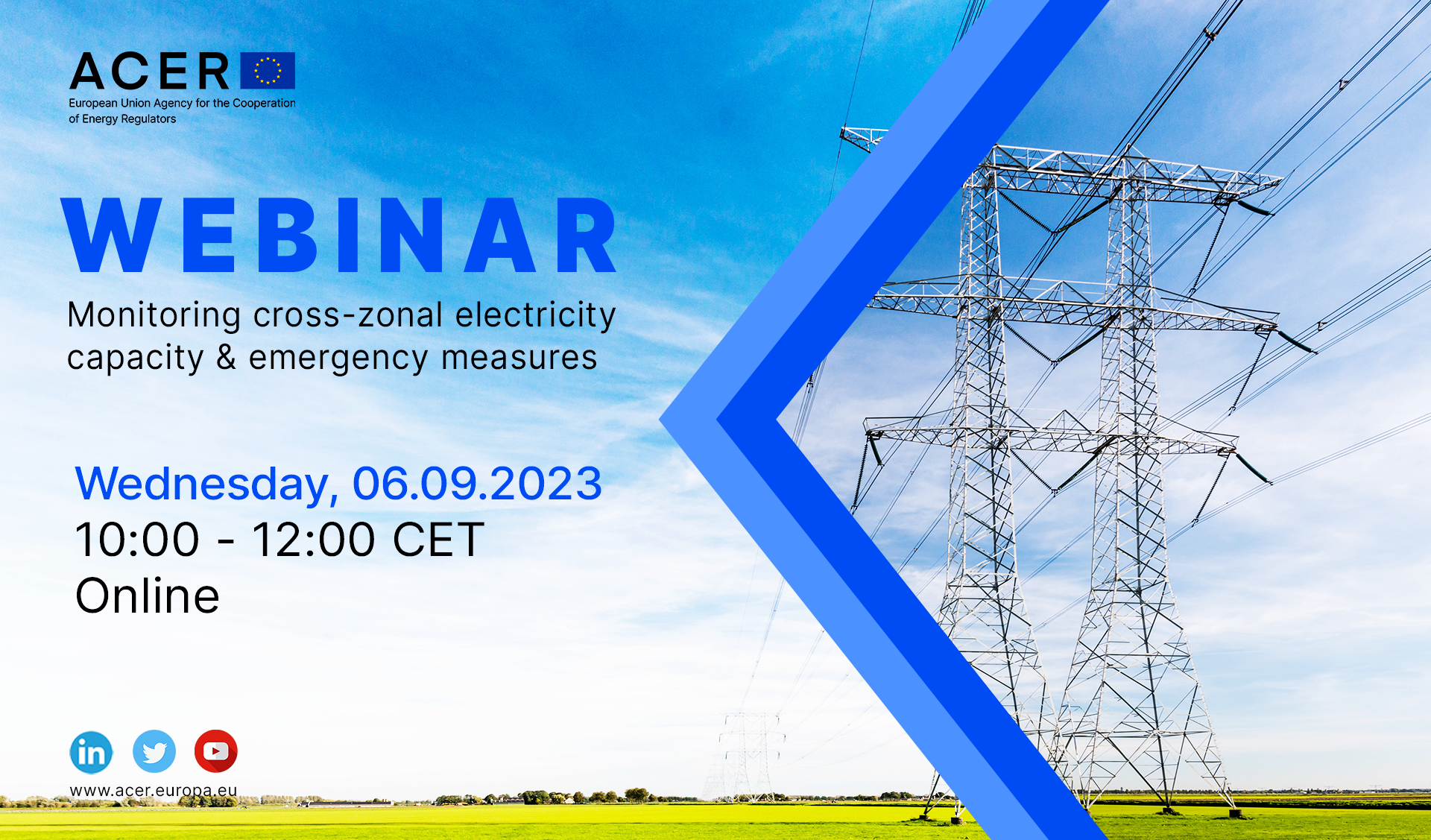ACER-CEER webinar: Monitoring energy retail markets and consumer protection
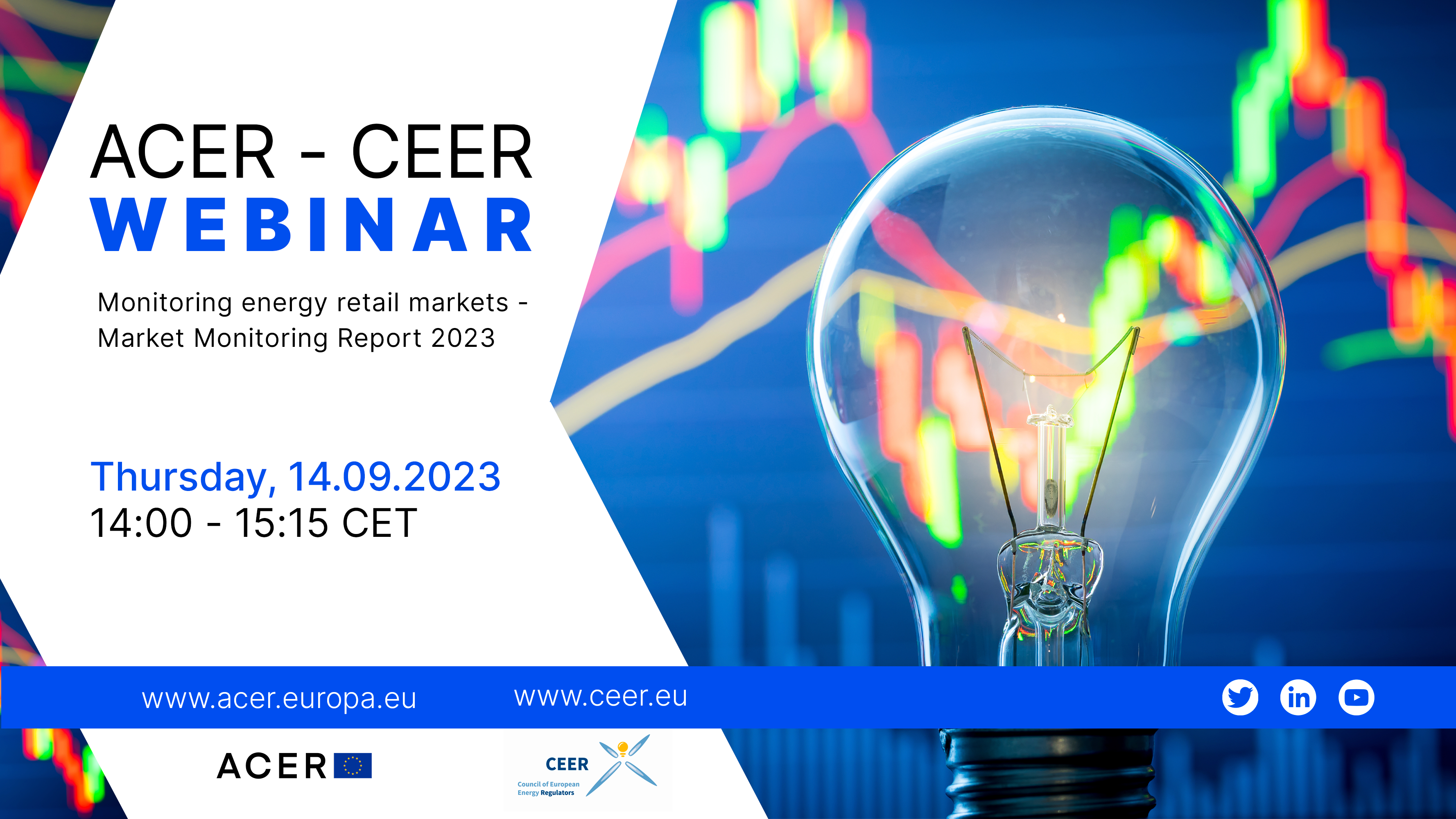
ACER’s latest REMIT Quarterly announces the REMIT Forum 2023

ACER’s latest REMIT Quarterly announces the REMIT Forum 2023
What is it about?
REMIT (Regulation on Wholesale Energy Market Integrity and Transparency) provides an EU framework for the transparency and integrity of energy markets and deters market participants from manipulating the market. It therefore has an important role in protecting the interests of companies and consumers and ensuring trust in energy markets.
What is the REMIT Quarterly?
The REMIT Quarterly is ACER’s main channel of communication with stakeholders on REMIT-related matters, providing updates on ACER’s REMIT activities.
The 33rd edition comes in a new format with an increased content scope and covers the second quarter of 2023, featuring:
- Announcement of the 7th ACER REMIT Forum, taking place on 5 December 2023 (online);
- Analysis of and recommendations on non-intuitive commercial exchanges in Single Day-ahead Coupling (SDAC);
- Statistics for registered reporting mechanisms’ (RRMs’) contingency reports;
- Updated overview of the sanction decisions for the past four quarters, with 372 REMIT cases under review at the end of the second quarter of 2023;
- A brief overview of trading on organised market places in the second quarter of 2023; and
- Other latest REMIT updates.
Access the 33rd issue of REMIT Quarterly.
Access all issues of REMIT Quarterly.
ACER urges market participants to improve the quality of reported LNG data

ACER urges market participants to improve the quality of reported LNG data
What is it about?
Since 31 March 2023, ACER has been producing and publishing its daily Liquefied Natural Gas (LNG) price assessments and benchmarks, as required by Council Regulation (EU) 2022/2576. The Regulation also imposes data reporting obligations on LNG market participants.
ACER regularly reviews the reported data to ensure its consistency with the LNG data reporting requirements. Since the start of LNG data reporting, ACER has observed data quality issues related to:
- Completeness;
- Timeliness; and
- Accuracy of the reported data.
ACER’s Open Letter on LNG market data quality
In its Open Letter on LNG market data quality, ACER highlights the most frequently observed data quality issues and urges LNG market participants to improve the quality of the reported data by:
- Diligently addressing any data quality issues;
- Promptly informing ACER of such issues; and
- Proactively ensuring compliance with the reporting requirements outlined in the ACER’s LNG data reporting guidance.
Good quality of the reported LNG data will enable ACER to more effectively monitor the LNG market for its LNG price assessments and benchmarks.
ACER remains committed to fostering engagement opportunities and information exchange through webinars and other activities to assist interested parties in addressing LNG data quality issues.
ACER calls for gas system operators to tackle gas transmission bottlenecks
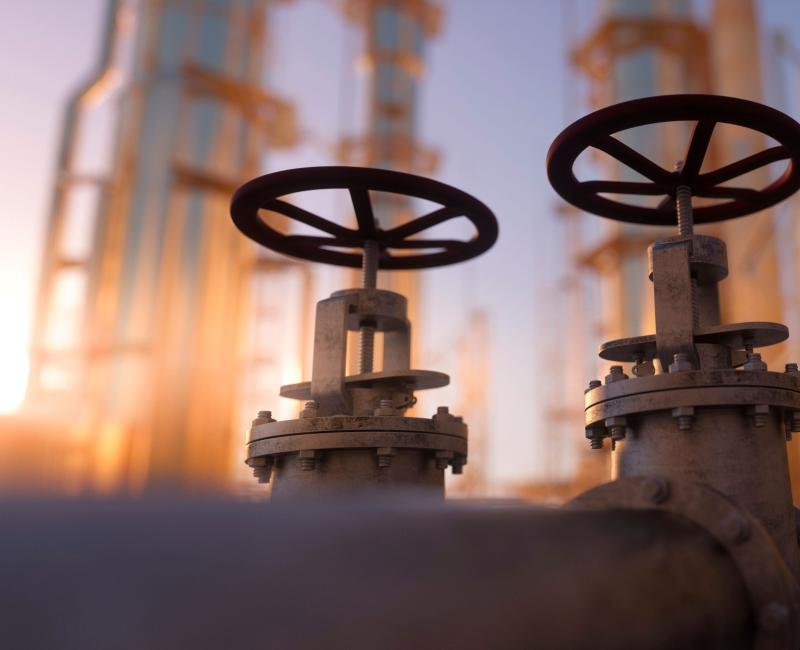
ACER calls for gas system operators to tackle gas transmission bottlenecks
What is the report about?
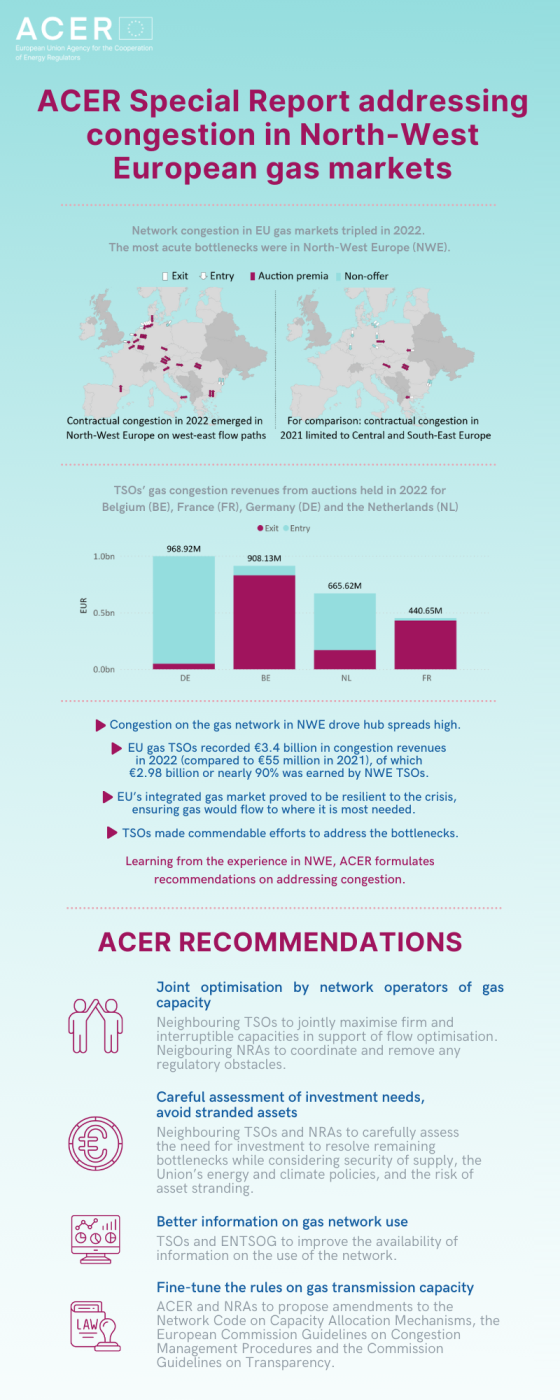
The European gas system was gas primarily designed for transportation of Russian supplies from east to west. Following the Russian invasion of Ukraine, Liquified Natural Gas (LNG) and increased pipeline supplies began to enter Europe from the west, which caused bottlenecks in North-West Europe (NWE).
Addressing congestion in North-West Europe
In addition to its annual monitoring of congestion, ACER publishes today its Special Report on addressing congestion in North-West European gas markets. The report examines:
- How acute bottlenecks emerged in Belgium, France, Germany and the Netherlands;
- How the respective Transmission System Operators (TSOs) and National Regulatory Authorities (NRAs) addressed the bottlenecks; and
- The lessons learnt.
What did ACER find?
- Congestion on the gas network in NWE drove hub spreads high.
- TSOs benefitted from significantly higher congestion revenues in 2022 (compared to 2021). EU TSOs recorded €3.4 billion in gas congestion revenues in 2022 (of which €2.98 billion or nearly 90% was earned by NWE TSOs); for comparison, EU’s total gas congestion revenues in 2021 were €55 million.
- The EU’s integrated gas market proved to be resilient to the crisis, facilitating the reconfiguration of supply and demand, and ensuring gas would flow to where it was most needed;
- TSOs made commendable efforts to address the acute physical bottlenecks from Belgium to the Netherlands, from Belgium to Germany and from France to Germany by increasing the gas capacity (kWh/h) available;
- But, while there was coordination among neighbouring TSOs, such coordination and information availability weakened while striving to maximise the availability of firm and interruptible capacities on both sides of the borders under difficult circumstances. This resulted in mismatched transmission capacities. In addition, the availability of information on the optimised network could be improved. Hence, a key learning is the need for continuous coordination and information sharing.
During an energy crisis, short-term mitigating actions are important:
- Europe’s voluntary gas-demand reduction target has been extended until 31 March 2024;
- The storage-filling targets agreed in 2023 were updated for 2023.
No-regret measures include:
- Addressing the most acute gas bottlenecks (in this instance, NWE) to improve market efficiency in the short term;
- Optimising existing infrastructure to accommodate new gas supply routes.
ACER recommends:
- Joint optimisation by network operators of gas capacity;
- Better information on gas network use;
- Careful assessment of investment needs to avoid stranded assets;
- Fine-tune the rules on gas transmission capacity.
Access the ACER Special Report on addressing congestion in North-West European gas markets.
Access reports' infographic.
ACER calls for improvements to the proposed Greek gas transmission tariffs
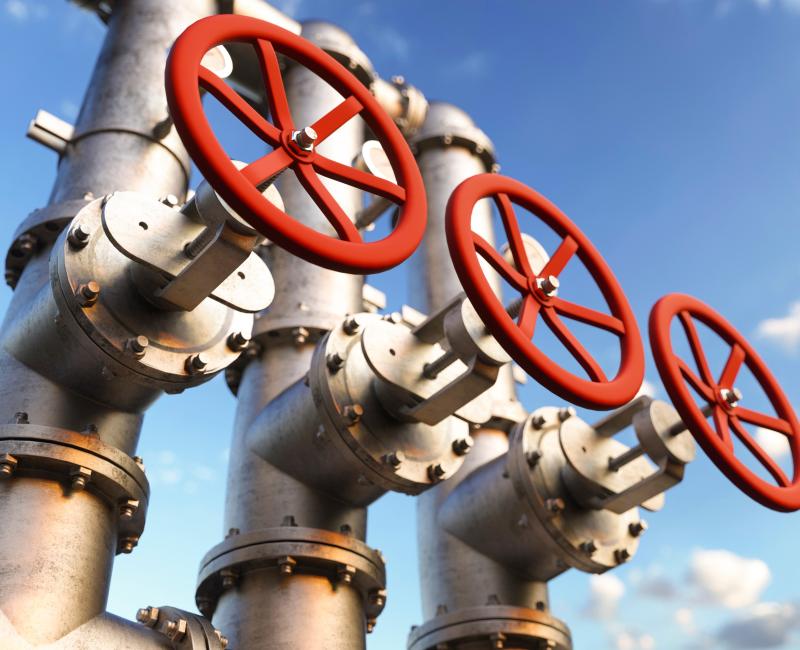
ACER calls for improvements to the proposed Greek gas transmission tariffs
What is it about?
ACER publishes today its report on proposed gas transmission tariffs in Greece.
What is in the report?
ACER assessed the proposed tariff methodology to calculate the natural gas transmission network in addition to the charge used to allocate part of the costs of the Revithousa LNG terminal to users of the Greek gas transmission network.
What are ACER’s main findings?
ACER notes that the Greek gas transmission network has seen a significant change in recent years, as a result of the construction of new infrastructure and the changing flow patterns. In the coming years, Greece could become a landing point for LNG to be transported to North Macedonia, Bulgaria and beyond via different interconnection points in the North.
ACER finds that the choice of the postage stamp methodology and the network charge to allocate the costs of the Revithousa LNG terminal should be further substantiated.
ACER recommends to the Greek national regulatory authority, RAE, to assess the possibility to set tariffs based on locational signals in the future. This can provide investment signals for future investments, enabling efficient decisions over the potential expansion of the network.
Access the report on the Greek gas tariffs.
Access all ACER reports on national tariff consultation documents.
ACER approves three methodologies on electricity balancing capacity procurement

ACER approves three methodologies on electricity balancing capacity procurement
What is it about?
Electricity grid operators must keep the power system stable or in balance. Decreasing the volume of balancing capacity to ensure operational security and allocating cross-zonal capacity to balancing capacity enables the power system to be balanced more efficiently.
To enable this, ACER approved on 19 July 2023 three proposals of Transmission System Operators (TSOs) and the European Network of Transmission System Operators for Electricity (ENTSO-E) on:
- Harmonised methodology for cross-zonal capacity allocation for the exchange of balancing capacity or sharing of reserves;
- Regional Coordination Centres’ (RCCs) task of regional sizing; and
- RCCs’ task of facilitating the procurement of electricity balancing capacity.
How is this relevant for citizens and EU security of electricity supply?
This new ACER Decisions aims at better integrating balancing capacity markets through the use of cross-zonal capacities. The goal is to lower the costs of procuring electricity balancing capacity while ensuring security of supply. This can be achieved by reducing the overall balancing capacity needs and by lowering the procurement cost for acquiring the necessary balancing capacity.
To ensure the informed decisions, ACER gathered input via a:
- Workshop (19 April 2023); and a
- Public consultation (13 April – 15 May 2023).
What are the next steps?
- ENTSO-E, TSOs and RCC start the implementation of these methodologies.
- The harmonised market-based allocation process should be ready for application in 2 years.
- The RCC task of facilitating the procurement of electricity balancing capacity should be operational in 2.5 years.
- The RCC task of regional sizing should be operational in 3 years.
- TSOs will submit an amendment proposal of the harmonised methodology for cross-zonal capacity allocation for the exchange of balancing capacity or sharing of reserves in 1 year to include needed provisions for the governance of the market-based process.
- Based on further assessments, ENTSO-E will submit amendment proposals for the RCC task methodologies before they enter into operation to define required thresholds.
Access the:
- ACER Decision No 11-2023 on the TSOs’ proposal for the harmonised cross-zonal capacity allocation methodology.
- ACER Decision No 12-2023 on the Regional Coordination Centre Regional Sizing of Reserve Capacity Methodology.
- ACER Decision No 13-2023 on the Regional Coordination Centre Regional Procurement of Balancing Capacity Methodology.
ACER’s monitoring finds much at stake as grid operators are still far off making 70% transmission capacity available for cross-zonal electricity trade

ACER’s monitoring finds much at stake as grid operators are still far off making 70% transmission capacity available for cross-zonal electricity trade
What is it about?
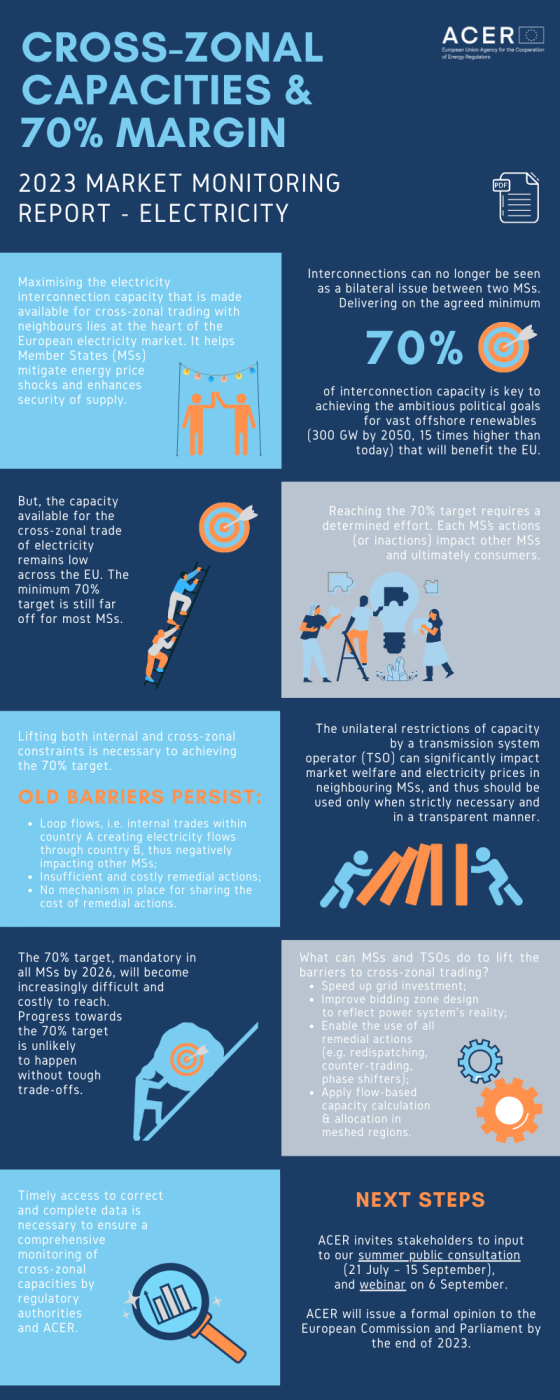
EU rules require grid operators to make a 70% minimum amount of capacity on interconnectors available for electricity trading with neighbours by the end of 2025. It is ACER’s job to monitor how Member States are doing on reaching this 70% target, but ACER’s monitoring finds that the target is still far off.
ACER is inviting feedback on its monitoring report and holding a webinar to discuss its conclusions (together with the recently published Emergency Measures report) on 6 September.
Why is reaching the minimum 70% target important?
- Delivering on the agreed minimum 70% target of interconnection capacity is crucial to achieving the ambitious political objectives set for renewable generation.
- Reaching the 70% target will:
- ensure security of supply;
- mitigate price volatility; and
- provide key flexibility to the market.
- Building new lines is difficult and environmentally challenging: The 70% target allows for a more efficient use of existing lines.
- The 70% target will become increasingly difficult and costly to reach. Progress towards the 70% target is unlikely to happen without tough trade-offs.
What is the report about?
- Highlights the need for maximizing cross-zonal trading to reach the EU’s clean energy goals;
- Evaluates progress towards achieving the 70% target by the end of 2025;
- Analyses the main barriers to cross-zonal trading and outlines what Member States and Transmission System Operators (TSOs) can do to lift them; and
- Illustrates the impact on welfare and on price spikes of offering low cross-zonal capacity levels in day-ahead electricity markets.
What are the key findings?
- Interconnection capacity available for cross-zonal trade of electricity remains low across the EU. The minimum 70% target of interconnection capacity is still far off for most Member States.
- Reaching the 70% target is a collective effort: Each Member State’s actions (or inactions) impact other Member States and ultimately consumers.
- Lifting both internal and cross-zonal constraints is necessary to achieving the 70% target. Old barriers persist:
- Loop flows, i.e., internal trades within country A creating electrical flow through country B, thus creating congestion;
- Insufficient and costly remedial actions;
- No mechanism in place for sharing the cost of remedial actions.
What are the next steps?
- ACER’s public consultation (from 21 July to 15 September 2023) invites stakeholders’ views on the findings of the ACER monitoring report.
- ACER’s webinar (6 September 2023) presents and discusses the report’s conclusions (and the recent ACER report on Emergency Measures).
- Based on the findings of the report and stakeholders’ input, ACER will issue a formal opinion, on capacity available for cross-zonal electricity trade, to the European Commission and European Parliament by the end of the year.
Access the ACER Report on cross-zonal capacities and the 70% margin available for cross-zonal electricity trade.
Access the Report's infographic.
ACER webinar: Monitoring cross-zonal electricity capacity & emergency measures
ACER webinar: Monitoring cross-zonal electricity capacity & emergency measures
